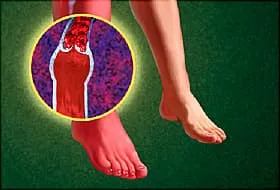After hurting your leg, you're probably dealing with some discomfort and inconvenience. But that's not all you have to be concerned about. This type of injury raises your chances for getting a blood clot.
Any time a blood vessel gets damaged, the nearby blood can thicken and organize into a sticky clump, or clot. Some clots only affect veins near your skin's surface. This condition, called superficial thrombophlebitis, typically doesn't lead to serious problems.
When a blood clot forms farther inside your leg, it's known as deep vein thrombosis (DVT). These clots can be dangerous if they break loose and travel to your lungs. Doctors call this a pulmonary embolism (PE).
What Kind of Injuries?
Trauma could result from a car accident, a sports injury, or even a fall. Common mishaps that may lead to a clot include:
- Broken bones
- Bad bumps
- Severe bruises
- Severe muscle injuries
A 2008 study revealed even minor leg injuries -- ones that don't need a cast or bed rest -- can raise your odds of having DVT. Researchers found as many as 1 in 13 blood clots may be caused by small problems, such as muscle tears or ankle sprains.
What to Watch For

Your leg could:
- Swell
- Hurt or feel tender, maybe like a cramp
- Feel warm
- Look red or discolored
- Have veins that stick out
If a clot moves to your lungs, you may:
- Cough up blood
- Have pain in your chest
- Feel your heart beat fast
- Have trouble breathing
- Hurt when you breathe
Call your doctor if you notice anything unusual or worrisome after a leg injury.
Who Is at Risk?
Some people are more likely than others to develop a blood clot. Your odds are higher when you:
- Have a close family member with DVT
- Are older
- Have a blood clotting disorder or a vein disease
- Have cancer
- Are pregnant
- Use birth control pills or hormone replacement therapy
Being overweight and smoking will raise your chances. Also, being a couch potato can lead to a clot.
While blood clots are less common in younger, healthy people, they're still possible. Fit athletes are likely to be injured, get dehydrated, and travel long distances for events. These things increase the odds of blood clots, too.
Prevent Clots
You might still be hurting from your injury, but activity is key for keeping clots at bay. Don't sit or stand for more than an hour at a time if you can help it.
Your doctor might tell you to wear special compression stockings if you have a higher chance for developing a clot.
Drink plenty of water, and stay away from alcohol, especially if you're traveling long distances.
Try not to hurt your legs again during your recovery. Losing extra weight and quitting smoking can lower your chance of getting a blood clot.

